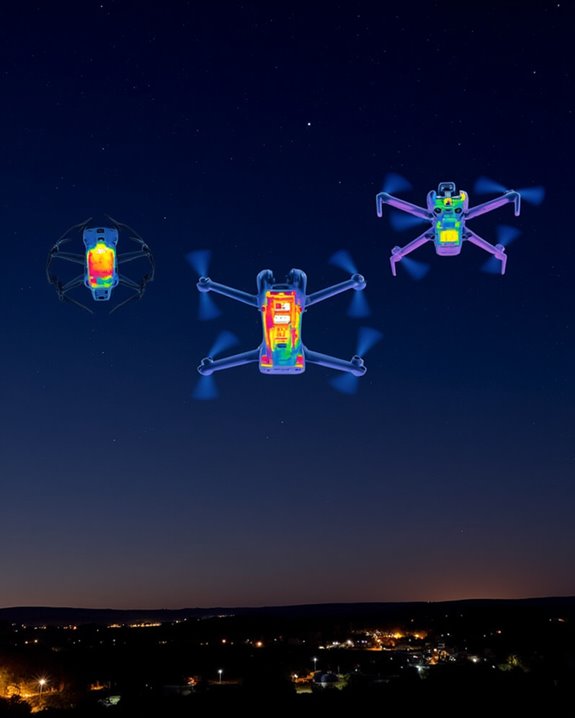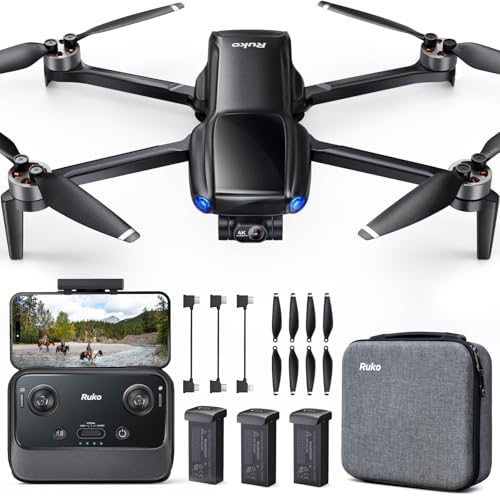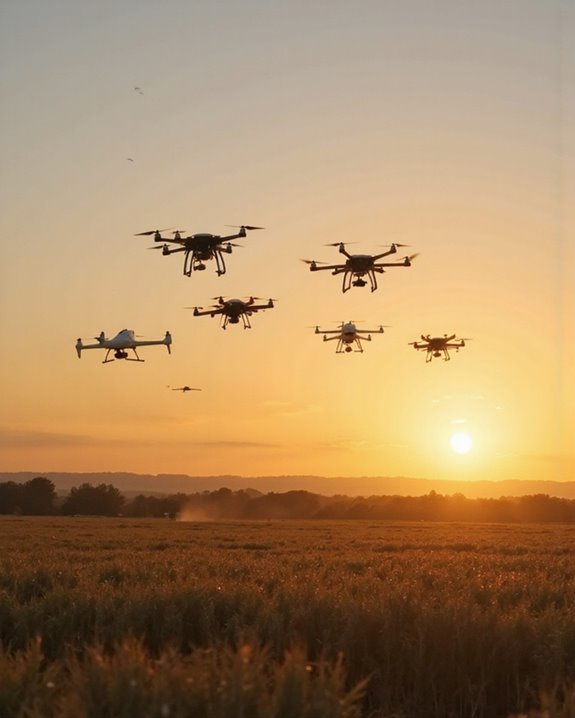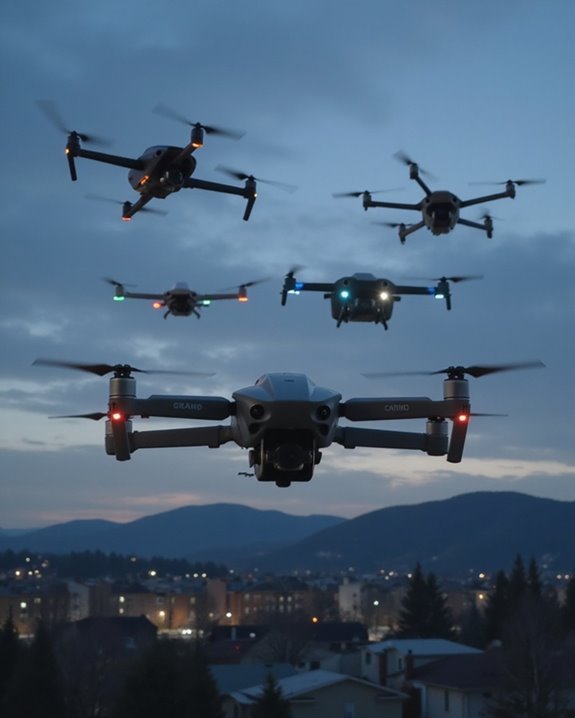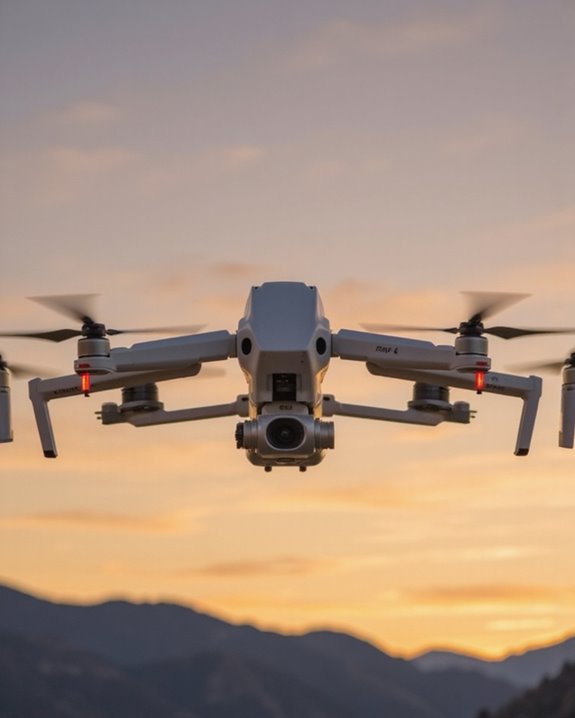Looking for cutting-edge thermal imaging in 2025? You’ll want to explore the Ruko U11MINI with its impressive 1/2-inch CMOS sensor and 96-minute flight time, the CANKETEC S159 featuring obstacle avoidance and follow-me mode, or the V11PRO with its Sony camera and 3-axis gimbal stabilization. Each offers unique strengths for thermal detection, from extended flight times to rock-solid stabilization. The perfect balance between weight, battery life, and sensor quality awaits in our detailed breakdown below!
Key Takeaways
- Infrared drone cameras require at least 1/2-inch sensors and higher resolutions (640×480+) for detecting fine temperature details in thermal imaging.
- 3-axis gimbal systems are crucial for professional-grade thermal imagery, ensuring stable heat signature detection even during aggressive flight maneuvers.
- Batteries exceeding 2000mAh provide the extended flight times (30-90 minutes) necessary for comprehensive thermal inspection missions.
- Thermal imaging drains power faster than standard camera operation, making multiple battery setups essential for uninterrupted inspection flights.
- Environmental factors like humidity, cold weather, obstacles, and dense vegetation significantly reduce both image clarity and effective transmission range.
Ruko U11MINI 4K Drone with Camera for Adults
- 【Ultra-Portable Pocket Drone】Weighing under 249g, the FAA-exempt U11MINI 4K pocket drone captures 4K aerial footage anytime, anywhere - no limits, no hassle!
- 【High Value & Ideal Gift】You'll get one 8K camera drone with 3 smart batteries, a sleek rechargeable transmitter, 3 charging cables, 3 types of connecting cables,...
- 【Stunning 8K Photo & 4K Video】Featuring a 1/2-inch CMOS sensor and 48MP resolution, the professional-grade camera drone captures 8K UHD photos and 4K/30fps videos to...
Adventure photographers and travel enthusiasts, you’ll find the Ruko U11MINI 4K drone hits the sweet spot for portability without sacrificing professional-grade imaging capabilities. Weighing just 248 grams (under FAA registration requirements!), this pocket-sized powerhouse delivers stunning 8K photos and 4K/30fps video from its impressive 1/2-inch CMOS sensor.
You’ll love the stability offered by its 3-axis brushless gimbal and EIS stabilization, making your aerial footage look silky smooth. With an incredible 96-minute flight time spread across three 2200mAh batteries, you won’t miss those perfect sunset shots. The drone’s 20,000ft FPV transmission guarantees you’ll maintain connection even during ambitious adventures, while safety features like auto-return and quadruple positioning keep your investment secure.
Best For: Travel photographers and adventure enthusiasts seeking a lightweight, portable drone with professional-quality imaging capabilities that doesn’t require FAA registration.
Pros:
- Impressive 96-minute total flight time with three included batteries provides extended shooting sessions without frequent recharging
- Professional-grade imaging with 8K photos, 4K/30fps video, and 3-axis gimbal stabilization delivers smooth, high-quality aerial footage
- Ultra-portable 248g weight falls under FAA registration requirements while maintaining advanced features like 20,000ft transmission range
Cons:
- Plastic construction may be less durable than premium metal-body alternatives in rough travel conditions
- Limited internal storage requires managing multiple memory cards or frequent transfers during extended shooting sessions
- Controller lacks built-in screen, requiring smartphone pairing for full functionality and monitoring
Drone with 4K UHD Camera for Adults, GPS RC Quadcopter with 60 Mins Flight Time
- 【Safety and After Sale Service】: ①Please watch the guide video on the guide page in the APP before flying and read the Manuals patiently to understand the...
- 【4K HD Camera with 2 Axis Gimbal & EIS Anti Shake】: With 2-Axis Gimbal & EIS, this Professional drone has a 100° FOV lens and larger COMS sensor Plus 20x digital...
- 【Smart and Easy to Control】The GPS drone will automatically return to the take-off point when the battery is low, signal is weak, or the return button is pressed....
The budget-conscious drone enthusiast looking for impressive flight time will find their match in the CANKETEC S159 GPS Quadcopter. You’ll enjoy a full hour of aerial adventure thanks to the two included batteries that provide 30 minutes each! While this model doesn’t offer thermal imaging capability, its 4K UHD camera with 2-axis gimbal and EIS anti-shake technology delivers respectable daytime footage.
The S159’s user-friendly features, including obstacle avoidance, follow-me mode, and one-key controls, make it perfect for beginners still mastering their piloting skills. Just don’t expect professional-grade video quality—the 3.6-star rating reflects some user disappointments with footage clarity, though many praise its durability and straightforward operation.
Best For: Budget-conscious beginners and hobbyists seeking extended flight time and user-friendly features without requiring professional-grade video quality.
Pros:
- Exceptional 60-minute total flight time with two included batteries
- Comprehensive beginner-friendly features including GPS, obstacle avoidance, and one-key controls
- Lightweight, foldable design with multiple smart flight modes (follow me, waypoints, trajectory flight)
Cons:
- Video quality doesn’t match professional standards despite 4K UHD label
- Some users report screen blanking issues and unexpected crashes
- Limited to 2-axis gimbal stabilization rather than the more premium 3-axis systems
V11PRO Drone with 8K Camera for Adults (3-Axis Gimbal Quadcopter)
- 【𝐒𝐭𝐮𝐧𝐧𝐢𝐧𝐠 𝟖𝐊 𝐈𝐦𝐚𝐠𝐞𝐬 & 𝟒𝐊 𝐕𝐢𝐝𝐞𝐨】: With the advanced camera and 1/2 CMOS, you can record...
- 【𝟔𝐊𝐌 𝐅𝐏𝐕 𝐃𝐢𝐠𝐢𝐭𝐚𝐥 𝐓𝐫𝐚𝐧𝐬𝐦𝐢𝐬𝐬𝐢𝐨𝐧】: The upgraded digital transmission system ensures a more...
- 【𝐄𝐱𝐭𝐞𝐧𝐝𝐞𝐝 𝟖𝟎-𝐌𝐢𝐧𝐮𝐭𝐞 𝐅𝐥𝐢𝐠𝐡𝐭 𝐓𝐢𝐦𝐞】: The package includes two batteries, each capable of...
Professional photographers and serious drone enthusiasts will find their match in the V11PRO Drone, a powerhouse quadcopter that combines impressive flight time with exceptional image quality. You’ll capture stunning 8K images and 4K/30fps video with the Sony camera while the 3-axis gimbal provides buttery-smooth footage, even when you’re chasing that perfect sunset shot!
With a remarkable 80-minute flight time from two 3500mAh batteries, you’ll never miss a moment. The 6KM transmission range gives you freedom to explore, and features like GPS cruise control and waypoint flight let you focus on creativity instead of controls. When you’re done playing aerial cinematographer, the drone automatically returns home on low battery—no more nail-biting landings!
Best For: Professional photographers, videographers, and serious hobbyists seeking a high-end drone with exceptional camera capabilities, extended flight time, and advanced autonomous features.
Pros:
- Impressive 80-minute total flight time with two batteries provides extended aerial shooting sessions
- Professional-grade 8K image capture and 4K/30fps video with 3-axis gimbal stabilization delivers cinema-quality footage
- Advanced safety features including automatic return, TOF sensors, and vision systems ensure reliable operation even for less experienced pilots
Cons:
- Relatively heavy at 650 grams, which may require registration in some countries and limit portability
- Premium features command a higher price point compared to entry-level camera drones
- The complex feature set might overwhelm beginners despite the user-friendly interface
Factors to Consider When Choosing a Drone Infrared Camera
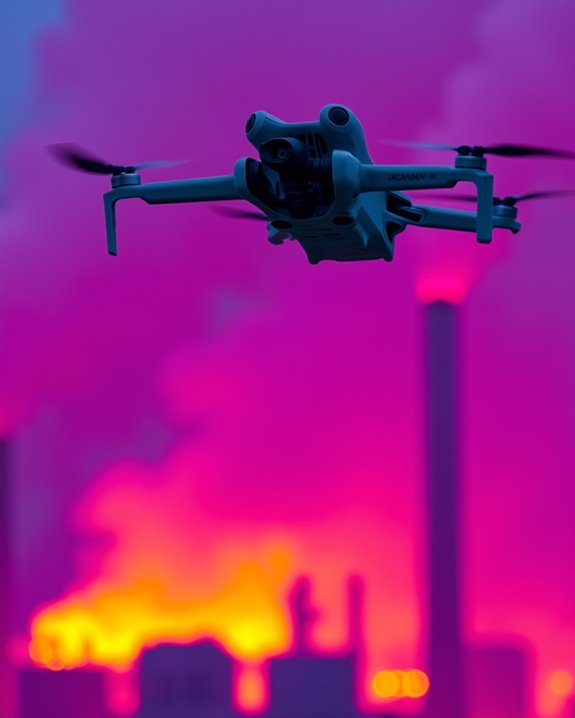
When shopping for an infrared drone camera, you’ll need to weigh several critical factors that directly impact your aerial thermal imaging experience. Your choice should account for image sensor size, battery consumption, and stabilization features, while also balancing resolution capabilities against effective range requirements. Don’t forget to evaluate the camera’s weight and portability—after all, you don’t want your drone struggling to take off because you’ve attached the equivalent of a flying brick to it!
Image Sensor Size
Because every stunning aerial thermal image begins with the sensor, understanding image sensor size is essential when selecting your infrared drone camera. In thermal imaging, size truly matters!
Larger sensors around 1/2-inch capture substantially more light, giving you cleaner images with less noise when surveying at dusk or dawn. You’ll appreciate how bigger sensors support higher resolutions—think 48MP thermal captures that reveal incredible detail in utility inspections or search operations.
The enhanced dynamic range from a larger sensor means you’ll catch both the hottest roof leak and the coolest foundation cracks in a single shot. While bigger sensors create that professional shallow depth of field, remember that drone performance requires balance. Most high-performing thermal drones use sensors under 1-inch to maintain flight stability without sacrificing image quality you’ll need for critical missions.
Battery Life Impact
Beyond sensor size, the battery life of your infrared drone camera can make or break your thermal imaging mission! You’ll need endurance for those thorough thermal surveys, with flight times typically ranging from 30 to 90 minutes depending on your model’s power efficiency.
Look for batteries exceeding 2000 mAh if you’re planning extended operations—nobody wants to head home mid-inspection because of a dead battery! Remember, thermal imaging features drain power faster than standard cameras, so efficient power management is non-negotiable. Smart features like auto-return when battery levels drop can save your drone from an untimely landing (and potentially expensive repairs).
Don’t forget that environmental factors matter too! Cold weather and heavy payloads will reduce your flight time, so choose a power system that can handle your specific mission requirements with some juice to spare.
Gimbal Stabilization Capabilities
The rock-solid gimbal stabilization system serves as your infrared camera‘s unsung hero, transforming shaky footage into professional-grade thermal imagery! When you’re hunting for heat signatures at 30 mph, the difference between a 2-axis and 3-axis setup becomes startlingly clear.
You’ll want to prioritize gimbals that stabilize across all three axes—pitch, roll, and yaw—as they’ll keep your thermal readings accurate even during aggressive flight maneuvers. The best systems integrate electronic image stabilization (EIS) and can reduce vibrations by several degrees, vital when you’re trying to spot that tiny heat leak! Brushless motor gimbals aren’t just quieter (your neighbors will thank you!); they deliver smoother operation and maintain camera alignment within just a few degrees of deviation, ensuring your thermal data remains consistent and reliable.
Resolution Vs Range
How often have you squinted at a blurry thermal image, wondering if that heat signature is a raccoon or your neighbor’s cat? The resolution-versus-range dilemma is real, folks!
When selecting your drone’s infrared camera, you’re basically choosing between seeing finer details up close or detecting heat signatures from farther away. Higher resolutions (above 640×480) deliver stunning clarity for identifying smaller temperature differences, but they’ll drain your battery faster and potentially reduce detection range. Meanwhile, lower-resolution cameras might extend your drone’s reach by up to 30%, perfect for surveying larger areas!
Environmental factors complicate things further—humidity can turn your crisp thermal image into a foggy mess. For ideal performance, look for cameras where higher resolutions maintain at least 50-70% of the baseline range. Your mission requirements should ultimately guide this important trade-off!
Weight and Portability
Serious adventurers know that every gram counts when you’re lugging equipment across challenging terrain! Those ultra-lightweight infrared drone cameras (under 250 grams) aren’t just easier to carry—they’ll often save you from registration headaches in many regions. You’ll appreciate how sub-300-gram models fit comfortably in one hand during fieldwork, making quick deployments a breeze.
The smart money is on foldable designs that compact to less than 14 inches, perfect for tucking into your pack between missions. While those hefty 500+ gram models might deliver rock-solid stability for precision imaging, you’ll pay for it with your aching shoulders! Remember to take into account weight distribution too, as a properly balanced drone reduces strain whether it’s flying or riding in your backpack. Your future self will thank you for choosing wisely!
Flight Time Considerations
While your drone’s weight affects how comfortably it fits in your pack, flight time determines how long you’ll actually capture those critical infrared images! For serious thermal imaging work, you’ll want to prioritize drones offering extended airtime – some top models can deliver up to 96 minutes of total flight when utilizing multiple batteries.
Battery capacity makes all the difference, with options ranging from 2200 mAh for lighter models to robust 3500 mAh powerhouses that keep you airborne longer. Smart operators often carry spare batteries, effectively doubling potential mission time to 80 minutes without interruption. Remember, your drone’s weight greatly impacts flight duration – those sub-250 gram ultralight models typically outlast their 650-gram cousins! And don’t overlook charging technology – drones featuring PD 3.0 fast charging will have you back in the air collecting thermal data while slower models are still juicing up!
Transmission Range Parameters
The transmission range of your infrared drone camera represents that invisible electronic tether connecting your controller to your eye in the sky! When searching for the perfect thermal drone, you’ll need to evaluate how far you can send your aerial scout without losing that precious data connection.
Most quality infrared drones operate on either 2.4 GHz or 5.8 GHz frequency bands, with ranges varying from several hundred meters to multiple kilometers. Remember, that impressive 5km range won’t help much if you’re flying between buildings or in dense forests! Environmental factors and obstacles can dramatically shrink your effective range, turning your high-flying thermal detective into a confused wanderer.
Don’t forget about latency and bandwidth, too—nothing ruins a precision inspection like a choppy, delayed video feed when you’re trying to spot those subtle heat signatures!
GPS Navigation Integration
Investing in a drone with robust GPS integration transforms your infrared camera from a simple heat detector into a precision mapping instrument! When your drone knows exactly where it is, your thermal imaging capabilities reach new heights of accuracy, typically within just a few meters of your target coordinates.
You’ll appreciate how GPS-enabled stability keeps your drone hovering steadily while capturing crystal-clear infrared images—no more blurry heat signatures! The automated waypoint navigation is a game-changer, letting you program systematic thermal scans while you sip your coffee (the drone does all the work!).
Don’t overlook safety features like auto-return functionality, which guarantees your expensive equipment comes home when batteries run low. Remember, the best infrared drones combine GPS with additional sensors to maintain reliable performance even in challenging urban environments where signals might play hide-and-seek.
Frequently Asked Questions
What Regulations Govern Infrared Camera Drone Use in Restricted Airspace?
In restricted airspace, you’ll need specific FAA authorization for infrared drone operations. You must follow Part 107 regulations, obtain proper airspace clearance through LAANC, and possibly secure additional permits for thermal imaging. Military zones, government facilities, and critical infrastructure require special permissions—don’t risk it! Your thermal camera’s capabilities might trigger privacy regulations too. Remember, infrared technology faces stricter scrutiny than standard cameras due to its ability to “see” through certain barriers!
How Do Infrared Drone Cameras Perform in Extreme Weather Conditions?
When it rains, it pours—and your infrared drone camera’s performance will suffer! You’ll find that most thermal imaging systems struggle in heavy precipitation, extreme cold, and intense heat. Water droplets obstruct thermal signatures, while freezing temperatures drain batteries faster. However, high-end models like the DJI Mavic 3T feature IP54 ratings for light rain resistance, and military-grade options can withstand harsher conditions. Always check your specific model’s operating temperature range before flying in challenging weather!
Can Thermal Drones Detect People Through Walls or Dense Foliage?
Thermal drones can’t “see through” walls, but they can detect heat signatures through foliage! Your drone’s thermal camera will pick up body heat in dense vegetation, making it great for search and rescue operations. However, walls completely block thermal radiation, so you won’t detect people inside buildings. The technology isn’t X-ray vision—it’s simply capturing heat differences. For best results in dense environments, you’ll want a high-resolution thermal sensor with good temperature sensitivity for those subtle heat variations.
What’s the Average Lifespan of an Infrared Sensor on Drones?
Just as your smartphone battery eventually loses its punch, infrared sensors on drones typically last 3-5 years with regular use. You’ll get the most life from higher-end models like FLIR’s Vue Pro, which can survive up to 7 years! Your usage patterns, storage conditions, and environmental exposure will greatly impact longevity. Remember, extreme temperatures are particularly tough on these sensitive components. Many manufacturers offer recalibration services around the 2-year mark to keep your thermal imaging crisp and accurate!
Are There Specialized Software Requirements for Analyzing Thermal Imaging Data?
Yes, you’ll definitely need specialized software for thermal imaging analysis! Programs like FLIR Tools, Testo IRSoft, and InfReC Analyzer let you extract temperature data, adjust parameters, and create detailed reports. Most thermal cameras come with basic software, but for advanced features like hotspot detection and 3D mapping, you’ll want premium options. Don’t worry though, many programs offer user-friendly interfaces with drag-and-drop functionality. The learning curve isn’t too steep once you get the hang of the temperature scales!

